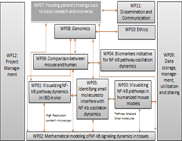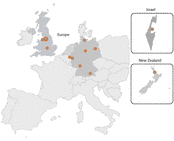WP11 - Dissemination and Communication
Objectives
- To ensure effective dissemination of project output with highest possible academic impact (Task 1)
- To establish efficient lines of communication with relevant commercial stakeholders (Task 2).
- To develop intimate links with patient groups and high-profile public exposure. (Task 3)
The objective of WP11 is to establish clearly defined lines of communication between SysmedIBD and all relevant groups within the academic, commercial and public sectors. While academic outputs will be disseminated through classical routes papers, conferences, web presence, reports etc interactions between SysmedIBD and commercial stakeholders and public groups will provide a conduit for two-way communication for sharing knowledge and expertise. As IBD is such a debilitating condition with complex individual aetiology and associated side-effects, we see interaction with patient groups and support networks as being a key information source for SysmedIBD.
Workpackage Description
WP11 will define how findings generated within the consortium are disseminated to other stakeholders, including patient groups. The essential need to communicate the activities and findings that define the success of SysmedIBD will focus within 3 broad areas:
1. Dissemination of findings within the academic domain.
2. Communication with commercial and industrial stakeholders.
3. Interaction within the public domain, with particular emphasis on patient groups.
Task 1: Dissemination of findings through classical academic routes
Research within SysmedIBD is motivated by the need to develop a much more detailed knowledge of the fundamental principles that lead to chronic inflammatory disease and then apply this information in order to improve patient outcomes and quality of life. A major output will be academic knowledge, which will be disseminated through the classical academic route: research publications, international and national conferences, internet presence, internal and published reports by the academic groups. The Academic outputs will be targeted to deliver the best possible level of scientific impact, by publishing in top journals and presenting
at top international meetings. In addition, GABO:mi will develop a high-profile web presence will be developed in order to disseminate project-related
information to the academic but alsoand wider communities with the highest level of efficiency. This webpage is accompanied by the Flyers for wider communities and by providing material that can be used for public engagement for public science fairs. Furthermore, the GABO webserver there will providebe a password-protected internal part of the website which is accessible only for project Participants. The internal part provides helpful documents, schedules, etc Individual WP leaders will be responsible for the dissemination of knowledge resulting from her/his WP, the project manager will co-ordinate the dissemination of the overall project results. In respect to conferences, many members of the SysmedIDB consortium have world leading reputations and high levels of exposure at academic meetings. For example, in the past 12 months 1cUNIMAN (Mike White) (WP11 lead) has been invited to 20 international meetings including Keystone Symposium on
Stem Cells, Cancer and Metastasis, Keystone Resort, Colorado, 6 11 March 2011. Systems analysis in single cells and International Conference on Systems Biology of Human Disease (SBHD), Boston, 22-24 June 2011.
This high level of exposure provides a perfect opportunity for dissemination of SysmedIBD outputs with the highest possible level of academic impact. 1c MW, 1b DJ and 1a WM in Manchester all have recent experience in organising international conferences and plan to host two international meetings related to the biomedical research focus of SysmedIBD (Manchester/Heidelberg) and two international technology training workshops (Manchester), for which we will seek additional funding from appropriate sources such as ESF and EMBO in addition to the budget for training and professional development of scientist within IBD. Dissemination of research outputs will continue at frequent points throughout the project. To support this task,GABO:mi in collaboration with 01cUNIMAN will develop a website for dissemination and communication.
Task 2: Engaging commercial and industrial stakeholders
Interaction with relevant commercial and industrial stakeholders is crucial to the success of biomedical endeavour in the present research climate. To emphasise the importance of collaboration between academic research and industry, the University of Manchester has recently set up the Manchester Collaborative Centre for Inflammation Research (MCCIR), with an initial £15 million award supported by equal contributions from UofM, AstraZeneca and GlaxoSmithKline. Close links between MCCIR and SysmedIBD will provide an immediate and efficient link with the major commercial stakeholders. To emphasise this point, GSK has already offered access to their comprehensive compound library as a source of potential drugs to modulate the inflammatory
response in IBD. From a commercial perspective, a major ethos of the FP7 programme is to stimulate economic development through engaging SMEs and it is important that the 3 SMEs partners within SysmedIBD are able
to develop tools, resources and associated intellectual property that will drive their continued success. This is an ongoing activity that will have outputs and frequent points throughout the project. 04WARICK has links to
software industry who may be interested in tools developed within SysmedIBD and 04WARICK has budgeted for such interactions which may require prototype development of a potential product.
Task 3: Connecting with patient groups and the wider public
Interaction with relevant patient groups is a key deliverable of SysmedIBD. At the beginning of the project, we will discuss intensively with patient groups in Germany, the Netherlands and the UK (annex for letters of support) to find the best way to integrate knowledge and experience of patients in managing IBD into experimental design. By engaging patient groups in this way we will foster intimate links in order to encourage a high degree of patient participation in SysmedIBD. To emphasise the importance of connectivity with patient groups we have invited one senior members of the UK IBD forum to participate as a member of the SysmedIDB Strategic Advisory Board (SAB, Fig. 10). Outreach to non-academic groups will be extended beyond patients and their families, who are affected directly by the severe consequences of IBD, in order to develop a wider recognition of the challenges that IBD suffers face. In this regard, the University of Manchester has experience in public engagement at various levels, including participations in local, national and international public outreach events and science fairs. With the recent re-location of the British Broadcasting Corporation HQ to Media City in Manchester, UofM has already developed strong links that are facilitating the development of high-profile public engagement through TV, radio and internet sources. These sources will be used to develop strong links between SysmedIBD and patient groups with the wide general public and used as a model to establish similar outreach programmes in other member states. Establishing effective communication between patient groups and the project partners will dramatically impact on how the disease condition is perceived by project partners. While initial interactions will be develop at the beginning of the project we anticipate that interactions will strengthen as the project proceeds.




